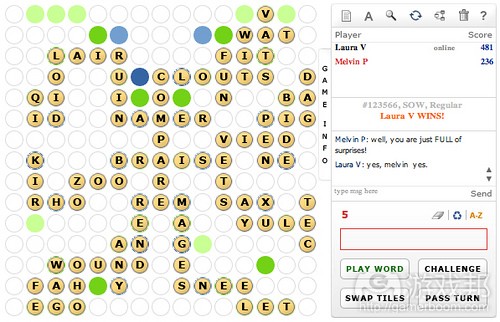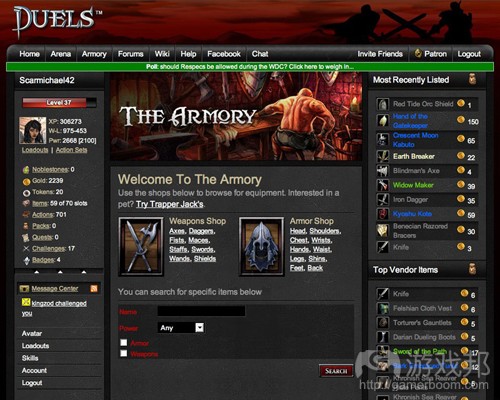异步游戏的优点及其机制的发展方向
作者:Soren Johnson
电子游戏同桌游和卡片游戏的差异性首在于实时互动。电脑可以自行处理所有的细节和挑战,允许两个或更多玩家同时玩相同的游戏。事实上,首款多人电子游戏取材于运动领域。《Pong》的灵感来源于乒乓球。这些早期的体验带有内在的同步性,也就是说玩家可以同时并在相同的设备上体验游戏。从那以后,同步性就成为了多人电子游戏的默认模型。随着网游的面世,参与这种体验的人甚至可以处于不同地方。
同步模型深藏于行业标准和传统中,看看《毁灭战士》、《星际争霸》、《无尽的任务》之类的游戏便可见一斑,这使得很少有设计师意识到同步性玩法只是种设计选择而已。异步玩法是设计师可选用的另一种方法,也就是说玩家可以在不同时间体验多人游戏。桌游提供了这种样式的游戏的范例,比如邮件象棋等。《Diplomacy》显然是这种样式中最成功的游戏,这款经典游戏的独特之处就是难以在同步玩法中实现的秘密谈判和隐藏条约。事实上,随着web的出现,许多非官方站点都会向玩家提供异步性的《Diplomacy》在线体验。
《Diplomacy》这款异步游戏的成功原因之一在于,它的每个回合都是同时执行的。换句话说,这款游戏不像象棋之类玩家轮流做出行动的游戏,所有在《Diplomacy》中的移动都是同时进行的。玩家将他们的命令秘密提交给游戏裁判,后者根据精心制定的规则处理所有的互动和冲突。这是种理想的异步体验样式,因为所有的玩家在每轮都要做出决定。《大富翁》之类的传统桌游会让异步体验的节奏变慢,因为大家多数时间都在等待其他玩家做出动作。因此,异步玩法能够为某些游戏机制带来便利,减少玩家的等待时间并提高玩家的参与度。
适合多种玩家的游戏
相比同步游戏而言,异步游戏有许多优势。首先,标准回合制游戏所需的时间减少。4名或5名其他玩家坐在桌旁等待某个动作缓慢的玩家做出决定,这种情况不会再出现了。其次,异步玩法同样支持多人游戏,仍然可以产生最丰富最具吸引力的体验,比较适合那些生活工作忙碌且休闲时间不确定的玩家。能够腾出精力参加长达4个小时的40人MMO团队活动的成年人并不多。相比之下,异步游戏允许大量的朋友一起玩游戏,只要每个玩家每天能腾出15分钟即可。在《Diplomacy》中,英国玩家可以在早上提交自己的行动,法国玩家可以将时间安排在晚上,这对所有玩家来说都极具便利性。
事实上,真正理想的在线异步游戏比《Diplomacy》在这一点上的表现更为领先。如果有玩家忘记在回合中做出行动时,《Diplomacy》的游戏会停止。但是理想的在线异步游戏的进程可以无视某些玩家是否做出行动而继续进行下去。事实上,虚拟体育游戏采用的就是这种模型。俱乐部成立后,无论玩家是否登录游戏,赛季每天的得分都会生成。但是,无论玩家每两周登录游戏一次还是每天登录游戏数次,他都是俱乐部的成员。这种模型的强势使得在线俱乐部游戏甚为流行,据Fantasy Sports Trade Association研究显示,2007年北美至少有3000万玩家(游戏邦注:这完全可以证明虚拟体育运动是世界上最流行的多人游戏)。在游戏中有不同投入的玩家可以一起玩游戏并且仍然可以享受游戏体验,这是典型的RTS游戏所无法达到的状态。
web上的异步游戏
现在AAA零售电子游戏中优秀的异步游戏并不多,只有某些老式战略游戏的邮件模式。就《文明4》而言,游戏中有个PitBoss模式允许多达32名玩家参与游戏,玩家可以在任意时间登录游戏来执行自己的回合。结合同步移动和24小时回合计时器,史诗游戏《文明》终于融入了异步样式。有人也说过专注单人作战内容的《魔兽世界》也是种异步玩法,玩家可以参与传统MMO游戏,不去安排团队活动或寻找组队。而且,排行榜和成就也是种架构于传统单人或同步多人游戏智商的异步互动形式,而且提升了游戏的社交性。
多数创新型的异步游戏存在于web上,而且已经根据这些异步互动构建起平台。诸如《Wordscraper》之类的许多Facebook游戏采用了回合制的游戏模式,同时使用平台上的社交网络来使得挑战好友变得更加简单。根据玩家投入程度的不同,两个好友间的游戏时间可以是几个小时或者几个月。现在也有了异步MMO游戏,比如Facebook上的《Mob Wars》和《Knighthood》、《Nile Online》和《Travian》。
所有这些游戏都允许玩家在某个庞大的世界中培养和发展某些实体内容,为了声望、挑战或单纯的升级乐趣。比如在《Nile Online》中,玩家可以控制尼罗河沿岸的一座城市,每座城市都有不同的资源,如雪松、黄金或石油。随着城市的成长,他们开始与附近的玩家贸易来获得他们所需的资源,比如用来雕刻的青铜或用来制作珠宝的绿宝石,也可以选择出售他们自己的剩余商品来获得盈利。最终,玩家会看到他们的城市逐渐在世界排名中上升,或者建造奇迹以获得更多的声望。
有意义的互动
虽然这些异步MMO确实拥有某些多人游戏环境下的优势,但他们面临的挑战是感觉起来更像是单人游戏。玩家互动变得相对不那么重要,因为多数机制关注的只是发展自己的领地,根本不用关心邻居的状况。让玩家间产生有意义的互动确实是种挑战,因为从定义上来说,系统只能假设每次只有一名玩家登陆游戏。如果玩家可以彻底摧毁其他玩家的城市,那么如果受攻击玩家正在睡觉怎么办?如果玩家醒来发现自己的所有心血毁于一旦而没有对抗攻击的机会,那可不算是有趣的事情。
因而,多数游戏都会采取措施来减少其他玩家动作的影响。比如在《Travian》中,玩家可以建造Cranny,当其他玩家攻击城镇是便会自动保护城中的资源。但是,这些机制最终会损害到游戏自身。如果像资源掠夺之类的零和机制过于强大使得异步玩法的优势(游戏邦注:即玩家可以自行安排玩游戏的时间)损失殆尽,那么开发者就应该将注意力集中在游戏的平行竞争机制上,比如建造奇迹或取得经济优势等。
尝试解决这个问题同时保持有意义的零和机制的异步网页游戏是《Duels》,在这款玄幻主题的MMO中角色通过与他人战斗来升级。系统带有异步性,因为角色的战斗并不需要玩家在线。但是,当某个战士要向某个巫师发起挑战时,只有巫师在当天接受挑战,战斗才能够进行。游戏的优势在于,冲突和互动仍然很有意义,同时玩家自身也可以根据自己的时间安排来玩游戏。但是,游戏中存在的问题是,因为战斗可以在玩家离线时发生,因此并没有在战斗期间做出有意义的决定。因而,战斗就像是个将两个角色放进去然后得出结果的“黑盒子”。如果优秀的游戏需要玩家能够做出一系列的决定的话,那么《Duels》的这种做法就相当于完全剥夺了玩家的控制权。
异步特有玩法
将来,异步多人游戏的潜在用户将大大超过同步游戏的潜在用户。因为所有有时间玩同步游戏的人都能找出玩异步游戏的时间,而异步游戏玩家却未必都有时间玩同步游戏。挑战在于,不是像现在这样模仿同步游戏,而是找出适用于异步样式的游戏机制,那些只在异步世界中起到作用的机制。此类游戏之一便是《Parking Wars》,玩家在这款Facebook游戏中可以通过在其他玩家街区上停留额外的时间来赚取金钱。技巧在于如果某量汽车属于非法停车,那么街区的主人可以通过开罚单的形式拿走汽车已经赚取的所有金钱。
所以,最佳的战略是知道好友何时不会检查他们的街区搜寻非法停车的车辆,利用这种技能来赚取金钱。当然,与之相反的策略便是在别人想不到的时间点上线查看自己的街区,收走好友赚取的金钱。所以,这款游戏聪明地将玩家离线的时间当成了游戏内容。与之前提到的其他异步游戏的机制不同的是,《Parking Wars》的规则在同步环境中完全无法发挥作用。将来异步游戏设计师也应当采取这种做法,不要再将同步机制移植到异步游戏中,而应该寻找适合这种样式的机制。
游戏邦注:本文发稿于2009年7月1日,所涉时间、事件和数据均以此为准。(本文为游戏邦/gamerboom.com编译,如需转载请联系:游戏邦)
Game Developer Column 6: Asynchronicity
Soren Johnson
One of the first things that separated video games from board, card, and parlor games was real-time interaction. The computer could handle all the details and challenges inherent in allowing two (or more) people to play the same game at the same time. Indeed, despite the name, the first multi-player video games may have had their roots more in sports than in games. Pong, after all, was inspired by table tennis. These early experiences were inherently synchronous, meaning that the players experienced the game together, at the same time, on the same machine. Since then, the synchronous format has been the default model for multi-player video games, and – with the arrival of online gaming – this same experience could be enjoyed even by people who were not necessarily in the same location.
The synchronous model is so deeply embedded in the standards and traditions of the industry – think Doom, StarCraft, Madden, EverQuest, and so on – that few designers consciously consider that synchronous play is simply a design choice. Another option exists – asynchronous play, meaning multi-player games that can be experienced in bite-sized chunks at different times for each player. The board-game world provides examples of games which can be played using this format, such as play-by-mail chess or wargames. The most successful game for this format is clearly Diplomacy, the classic game of back-stabbing, which rewards secret negotiations and hidden pacts difficult to achieve in a synchronous format. Indeed, with the appearance of the Web, a number of unofficial sites have sprung up giving players a moderated, asynchronous Diplomacy experience online.
One of the reasons Diplomacy works so well as an asynchronous game is that the turns are executed simultaneously. In other words, unlike sequential games like chess, in which players take turns performing actions, all moves in Diplomacy are done at the same time. Players submit their orders secretly to a gamemaster who then handles all interactions and conflicts according to the carefully crafted rules. This format is ideal for an asynchronous experience because all players get to make a decision every single turn. More traditional board games, from Risk and Monopoly to Carcassonne and Ticket to Ride, would slow down to a painful crawl in asynchronous play because the vast majority of turns are spent waiting for other players to make their moves. Thus, asynchronous play favors a specific style of game mechanics, ones which minimize waiting and keep players involved as much as possible.
Games for Real People
Asynchronous games hold a number of advantages over their synchronous counterparts. To begin, the time pressure of a standard turn-based game is eliminated. No more are 4 or 5 other gamers sitting around a table, waiting for the slow player to make up his mind. Instead, a player could take an hour deciding what to do without negatively impacting the flow of the game. Furthermore, asynchronous play allows multi-player gaming – still the richest, most engaging experience available – to fit the schedule of regular people with busy lives and unpredictable free time, across multiple time zones. Few adults can afford the total devotion required to participate in a five-hour, 40-man MMO raid. In contrast, an asynchronous game can allow a large group of friends to play together as long as each player can find 15 minutes per day to check the game. In Diplomacy, the English player can submit her moves in the morning, and the French can do it at night – or vice-versa – whatever works best for each one.
Indeed, the ideal online asynchronous game goes a step further than Diplomacy, which can still hang if one player neglects to send in a turn, by moving to a real-time format in which the game progresses regardless of an individual player’s specific actions. In fact, fantasy sports games follow exactly this model. Once a league is initiated, scores are tabulated each day of the season whether players log-on or not. However, the players are all full participants in their league whether they check their teams once every other week or hit the waiver wire multiple times per day. The strength of this model can clearly be seen by the astounding popularity of online fantasy leagues, with at least 30 million North American players in 2007, according to a study by the Fantasy Sports Trade Association. (In fact, a case could be made that fantasy sports are the most popular form of multi-player gaming in the world.) Players with different commitment levels can play together and still enjoy the experience – a statement which definitely cannot be made about your typical RTS.
Looking to the Web
Few good examples of asynchronous gaming exist for AAA retail video games, besides some play-by-email modes for older strategy games. For Civilization 4, we created a PitBoss (“Persistent Turn-Based Server”) option which allowed large games of up to 32 players in which players could log-on at any time to execute their turns. Combined with simultaneous movement and a 24-hour turn timer, epic games of Civilization were finally manageable thanks to the asynchronous format. One could also say that World of Warcraft’s focus on solo content is a form of asynchronous play, in that players could finally participate in a traditional MMO without needing to juggle the logistics of managing a raid schedule or looking for a pick-up group. Furthermore, Leaderboards and Achievements are also a form of asynchronous interaction layered on top of traditional single-player or synchronous multi-player games, enabling a extra level of socialization for gamers across multiple sessions.
However, most of the innovative asynchronous games exist on the Web, a platform already built upon asynchronous interactions. Many Facebook games, like Wordscraper (née Scrabulous), manage the persistence of simple turn-based games while using the social networking aspects of Facebook to make it easier to challenge one’s friends. Games can be played between two friends over a few hours or a few months – whatever matches their level of commitment. Asynchronous MMOs exist as well, such as Mob Wars and Knighthood on Facebook or Nile Online and Travian on their own sites.
All of these games allow players to grow and develop some entity within a larger world, for prestige or challenge or the simple pleasures of levellings. In Nile Online, for example, players control a city on the banks of the Nile, each one with a unique resource, such as cedar, gold, or oil. As the cities grow, they begin trading with nearby players to acquire the resources they need – perhaps bronze for sculptures or emeralds for jewelry – or to sell their own excess goods for a profit. Eventually, players can see their cities rise in the global rankings or create great Monuments for further renown.
Meaningful Interaction?
The challenge with these asynchronous MMOs is that, while they do have some of the advantages of a multi-player environment, they tend to feel more like a less predictable single-player game. Player interaction is fairly light as most of mechanics focus simply on developing one’s own domain, without much concern for the neighbors. Allowing meaningful interaction between players is a challenge because, by definition, the system can only assume one player is logged-on at a time. If one player could wipe out another player’s city, what if the latter player is asleep? Would it be fun to wake up and discover all of one’s hard-earned progress destroyed without a chance to counter the attack?
Thus, most of the games include options to lessen the impact of other players’ actions. In Travian, for example, a player can build a Cranny which automatically protect her resources when another player ransacks the town. However, these mechanics are ultimately self-defeating; player interaction is either meaningful or it is not. If zero-sum mechanics, like resource raids, are too powerful and negate the advantages of asynchronous play – the ability to set one’s own play schedule – then the developers should focus on the parallel competition mechanics of the game instead, building a Wonder first or achieving economic dominance.
One asynchronous web-based game which tries to solves this problem while keeping meaningful zero-sum mechanics is Duels, a fantasy-themed MMO in which characters level up by fighting one another. The system is asynchronous because players do not actually need to be online when their characters fight. Instead, a warrior might challenge a wizard to a duel, which is only played out when the wizard actually accepts the challenge later that same day. The advantage is that while the conflict and interaction is meaningful, the players themselves can still play the game at whatever pace they prefer without worrying about looking for games in the lobby or rage-quitters spoiling the battles. However, the problem is that, because players can be offline when combat occurs, no meaningful decisions actually occur during the duel itself. Thus, combat is a “black box” which takes in two characters and spits out a result. If a good game should be a series of interesting decisions, Duels paints itself into a corner by taking control away from the player.
Native Asynchronous Play
Truth to be told, asynchronous games are still in their infancy from a design perspective. Their future is promising as the potential audience for asynchronous multi-player games is much great than the potential audience for synchronous ones – although anyone who can find time for synchronous games can find time for asynchronous ones, the opposite is not true. The challenge is, instead of aping mechanics from established synchronous games, finding game mechanics native to the format itself, ones which make sense only in an asynchronous world. The best example of such a game is Parking Wars, a Facebook game in which players earn money by parking for an extended period of time on another player’s street. The trick is that if a car is parked illegally, then the owner of that street can steal all the money the car had earned by handing out a parking ticket.
Thus, the best strategy is knowing what times one’s friends are less likely to be checking their streets for illegally parked cars and using that knowledge to earn money. The counter-strategy, of course, is to check one’s own street at unexpected times to catch one’s friends trying to do the same. Thus, the game cleverly uses the actual time players are off-line as the game’s content. Unlike the mechanics of the other asynchronous games mentioned previously, the rules behind Parking Wars could not work at all in a synchronous environment. Designers of future asynchronous games should follow this precedent – the time has come to stop retrofitting synchronous mechanics into an asynchronous shell and to find the format’s native voice. (Source: DESIGNER NOTES)


